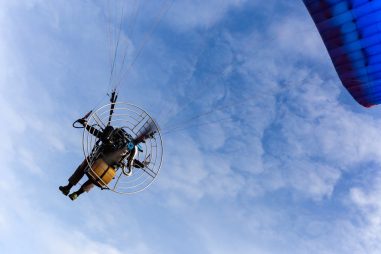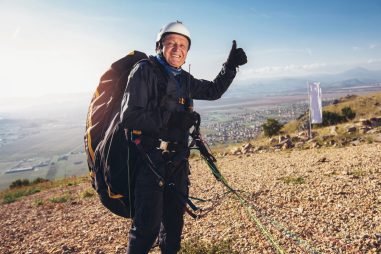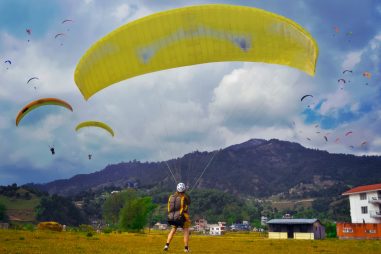In general, you need to have dry weather and winds not higher than 18 miles per hour (28.97 kph). The most ideal wind is between 2 and 15 miles per hour (3.22 and 24.14 kph). For beginners, it’s best to stick with winds not exceeding 12 miles per hour (19.31 kph).
What Weather Do You Need for Paragliding?
When it comes to paragliding, it’s best that you do it with dry weather. You can still do it while the skies are cloudy however, navigating might be a challenge for beginners.
You can paraglide in clear skies, cloudy skies, or overcast. Make sure that you also keep an eye on weather forecasts. Conditions may change at any time so knowing the forecast for the day will be very helpful for you.
The weather conditions you should be wary of when you paraglide are strong winds and when it is raining. It’s also best to wait it out if you see orographic or cumulonimbus clouds.
Can You Paraglide in Wind?
Having just the right amount of wind is perfect for paragliding. Wind assists you in staying longer when you’re mid-air. The better technique and refined skill you have, the longer you can paraglide in the wind.
To have a better flight, it is imperative for you to know and understand your wing. By doing this, you would have smoother and hitch-free paragliding. You also need to study wind dynamics as you would need to use this knowledge while doing the sport. A deeper grasp on wind direction and wind strength guarantees a safe and more fun flight for you.
Can You Paraglide Against the Wind?
Technically speaking, yes, you can paraglide against the wind. But this will be more difficult especially for beginners. Flying against the wind will take up a lot of your energy as you will need to find a powerful core.
This is also more demanding. It requires you to have an advanced understanding of wind direction and dynamics. Paragliding against the wind requires you to track changes in the wind. Ensure that you are knowledgeable in these areas before paragliding against the wind.
Do You Need Wind for Paragliding?
Generally speaking, you don’t need wind to launch a paraglider. While wind is helpful when doing the sport, the speed that you generate by running plus your weight and paraglider wing is enough. With the proper techniques and skills, you will find it easier to paraglide even without the aid of the wind.
Testing the wind strength before you paraglide will also give you an idea of how you should launch and land. In addition to this, it would also help you determine if you should continue with your flight, or postpone it.
Can You Paraglide Without Wind?
The wind is very helpful for beginners, especially when launching paragliders. This is not always the case for paragliding, though. While wind does help paragliders in staying aloft for longer periods, it is not a golden rule to have it all the time.
Ensure that you are well trained so you won’t be too reliant on the wind. It is best to pick a sloped site so that you can build up better for launching. It’s also good to check the wind speed if there’s any and make sure that it is within your ability to have a safe flight.
How Much Wind Do You Need for Paragliding?
As stated, you don’t need wind all the time to paraglide. But in the event that there is wind, it’s essential for you to know how much wind is safe to do the sport. You need around 2 to 15 miles per hour (3.22 to 24.14 kph) of wind to do the sport.
Invest in an anemometer so that you could get an accurate measurement of wind speed and strength. Make sure that you also test wind strength before paragliding. Doing so will help you decide what technique to use for launching and landing.
How Windy Is Too Windy for Paragliding?
Paragliding is very weather-dependent so you need to learn how to understand weather conditions and wind speed. It is important for you to know how to determine whether you’re going for a flight or postponing it. Winds that are greater than 18 miles per hour (29 kph) are dangerous so when you encounter this, it’s better to hold off.
As a beginner, you can already encounter many risks if you paraglide between 11 to 14 miles per hour (17.7 to 22.5 kph). Mainly, you need to be aware of the wind speeds when you launch. You also need to monitor wind speed while in mid-air to ensure a safe flight.
What Is the Best Wind Speed for Paragliding?
There are many factors that you need to remember when you measure wind speed. Remember that wind is changing—what you measure on the ground may not be the same while in the air.
Test the wind speed between two-minute periods. If you notice that the wind speed changes more than 2 meters per second (4.47 mph) within this timeframe, it’s gusty. This will cause the risk of being flown backward. This also increases the chances of you experiencing turbulence and difficulty in landing.
Ensure that you also know how to determine wind gradient—change of wind strength and direction. This happens when low moving air is slow, causing an increase in wind as paragliders ascend. As a result, this will blow you back as you increase in height soon after your launch.
Take note of the following speeds for your safety:
- 1 Meter per Second (2.24 mph): This wind strength is very calm. You would need to put in a lot of effort in running for your take-off with this speed.
- 1 to 3 Meters per Second (2.24 to 6.7 mph): With this speed, both forward and reversed launches are possible. This is still considered light and you would still need a fair amount of running for launching.
- 4 to 6 Meters per Second (8.95 to 13.42 mph): This is moderate wind strength and only demands a small amount of running. Reverse or front launching is possible with this wind speed.
- 7 to 10 Meters per Second (15.66 to 22.37 mph): If you are not an experienced pilot yet, it’s best to consider paragliding another day. Wind strength is strong with this. There is a high possibility that you will experience turbulence.
- 11 to 13 Meters per Second (24.6 to 29.1 mph): This speed is very strong. There will be a high chance that you will be landing backward. You will also experience strong turbulence and difficulty in controlling the canopy. Only experienced paragliders should consider flying at this speed.
- Above 14 Meters per Second (31.32 mph): Once the wind reaches this strength, it will be too dangerous to fly.
Can You Go Paragliding in the Rain?
Paragliding in the rain is extremely dangerous. Older paraglider wings will absorb rain as these are not waterproof. This will make your wing heavier and more difficult to control. While newer wings won’t absorb rain, it will still affect the air to travel across the wing’s surface.
It is vital that you always check the weather forecast for the day before paragliding. In the event that you do get caught in the rain, try your hardest to regain control. You should also apply the speedbar and keep it engaged. Look for a safe place to land as soon as possible to ensure your safety.
Apart from the rain, you should also avoid paragliding when you see these types of clouds:
- Orographic Clouds: These can form around a hillside. This type of cloud would render very minimal to zero visibility—which may cause you to run into flying objects. As paragliders, you should always meet full visual meteorological conditions.
- Lenticular Clouds: This means strong winds high up—which causes a wave to develop in the atmosphere. The air goes upwards along the hill slope and heads down the other side. This results in having some areas to be calm and some windy.
- Cumulonimbus Clouds: Seeing clouds like these is a good indicator to avoid flying. Clouds like these can cause strong updrafts and downdrafts of up to 200 miles per hour (321.87 kph). Cumulonimbus clouds may also entail heavy rain, strong winds, sudden lifts, and lightning.
Is Paragliding Seasonal?
Paragliding is possible any time of the year. There is no particular season that you cannot paraglide—as long as weather conditions permit. The weather requirements for paragliding are also not complicated. Even with the lack of wind, you can still paraglide.
Your only enemy would be rain. Paragliding wings are not made to withstand continuous rains so this makes paragliding very difficult. If there is rain, it is better for you to postpone your flight to ensure your safety.
Which Season Is Appropriate for Paragliding?
The good thing about paragliding is that you can do it all year round. Any season is appropriate to paraglide. Of course, this does not mean that you can do it any day of the year. As long as you meet the right weather requirements, paragliding at any season is possible.
As there is no guarantee of what weather conditions are for each season, it’s best that you regularly check the forecast. Remember to do your research and look out for any rainy days. If you are planning to go paragliding in another country, make sure that you check the weather days in advance.
Can You Go Paragliding in the Winter?
As stated, paragliding can be done any time of the year so doing it in winter is possible. It’s important to note that winter does not always mean cold and windy. There are other places where it is nice and warm. However, there are still some factors you need to consider if you’re planning to paraglide in winter.
Remember to always check the weather and take note of any changes. Wear clothes that are appropriate for winter as well. It’s also advisable that you inspect the place first before paragliding. Do not take any risks. Keep in mind the wind as well. The winter season also means that there are higher chances of strong winds. If you observe this, it is better to move it to another day.
Can You Paraglide in Snow?
Paragliding in the snow is a bit more challenging. In snow, you’d have to think of the stronger winds it brings. You should also consider the gusts that might cause you to lose control of your paraglider.
While you can still paraglide in snow, there are some things you should take into account first. Winds can be unpredictable and stronger. Landing would also be more difficult especially if the site is covered with snow. As much as possible, don’t paraglide in the snow if you’re not an expert yet.
What Is the Best Time to Do Paragliding?
The best time to do paragliding is generally when the weather is dry. It’s also best to do it when there is absolute visibility of your surroundings. Having a great view of what is under you will aid you better in flying—be it launching or landing. Clear skies are best, but not a necessity.
The specific times of days to do paragliding also depends on the season. For autumn and winter, you should opt for some time between 10:30 AM to 5:00 PM. During spring and summer, the best time is usually from 9:00 AM to 6:00 PM.
What Are Good Conditions for Paragliding?
Although paragliding is weather-dependent, the requirements to meet good conditions are not complicated. You generally just need to avoid rain, very strong winds, and lightning. Anything that is outside of those forecasts is good for paragliding. In fact, you can still perform the sport in cloudy skies or overcast. Paragliding conditions do not always need to be sunny.
If you are just starting out with the sport, it is advisable to paraglide in winds not higher than 12 miles per hour (19.3 kph). Remember to check the forecast before going for a flight so you can ensure your safety. You could even paraglide on a cloudy day as long as there are no rain predictions. You are also looking for conditions that have wind from 2 to 15 miles per hour (3.22 and 24.14 kph). Lastly, don’t forget to enjoy and bask in the view beneath you!







